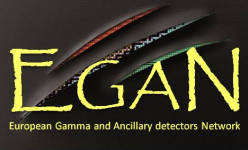Speaker
Barna Mátyás Nyakó
(Institute of Nuclear Research of HAS)
Description
DIAMANT is a light charged particle detector system of CsI(Tl) scintillators having a nearly 4π solid angle coverage. It has been developed in a collaboration by ATOMKI (Debrecen), CENBG (Bordeaux) and the University of Napoli (Naples). It has been used within the gamma-ray spectrometer arrays EUROBALL, EXOGAM and AFRODITE, as an ancillary detector to select or reject coincidence events including emitted charged particles, mainly protons and alphas. Recently it was mainly used within EXOGAM, at GANIL, the present VXI electronics of which is to be replaced by digital signal processing (DSP) electronics - the aim of the EXOGAM2 collaboration. The planned modernization of that electronics and the experience collected during the experiments done within the last decade motivated a feasibility study the aim of which is the possible upgrade of DIAMANT. In this contribution we give a report on the ongoing developments as for test measurements using avalanche photodiode (APD) readout instead of the present pin-photodiode readout of the scintillation light. Results on the use of a new, low-consumption preamplifier, and a prototype 4-channel DSP electronics developed at ATOMKI will also be presented. If test measurements using proton and alpha beams of our cyclotron can be completed in time, a comparison of performance between APD-based and pin-PD based detectors will also be discussed, besides tests done with radioactive sources. The particle discrimination capabiility of the detectors will also be compared when using NIM-based and DSP-based electronics.
Primary author
Barna Mátyás Nyakó
(Institute of Nuclear Research of HAS)
Co-authors
Mr
Dávid Nagy
(University of Debrecen)
Mr
Gyula Hegyesi
(Institute of Nuclear Research of HAS)
Dr
Gábor Kalinka
(Institute of Nuclear Research of HAS)
Dr
János Gál
(Institute of Nuclear Research of HAS)
Dr
János Timár
(Institute of Nuclear Research of HAS)
Dr
József Molnár
(Institute of Nuclear Research of HAS)
Dr
Katalin Juhász
(Dept. Inf. Techn., University of Debrecen)
Mr
Kristóf Szitha
(University of Debrecen)
Dr
Zsolt Dombrádi
(Institute of Nuclear Research of HAS)

